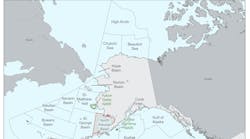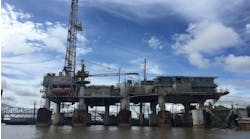US ultra-deepwater probes closing in on controversial area
William Furlow
Contributing Editor
As technology grows so does interest in the no-man's land. [45,838 bytes]Two hundred miles southeast of the southern tip of Texas lies - a triangular area of ocean technically refereed to as the Western "Gap," and commonly referred to as the "donut hole". This expanse of ultradeep water does not belong to the US or Mexico, and has been in limbo for almost 20 years.
In 1978, the Mexican Senate ratified the current border between the US and Mexico that runs from 12-200 miles offshore. This invisible line is still considered a provisional treaty line, but has been observed and respected by both countries despite the fact that the US never officially ratified it, according to Tom Readenger, deputy associate director of offshore operations for the US Minerals Management Service.
Beyond this 200 miles limit is the beginning of the Western Gap. This area has never officially been divided up, but the US has determined, under the Law of the Sea, that it controls everything north of the Gap's equidistant line.
Far from being an arbitrary line bisecting the Gap, this boundary was determined using a complex series of arcs and tangents drawn from the coast line. The formula applied com plies with the Inter national Law of the Sea, established in 1994, but gives the US only about one-third of the Gap's area.
"Equal distance is the most commonly accepted principal," Readenger said. As with the provisional treaty line, the division of the Gap is not official, but the US feels comfortable claiming land beneath the water at this equidistant line and will stand behind this assertion, furthermore Mexico has never contested this claim, Readenger said. "We are prepared to stand behind that line, the US asserts it."
Contesting the gap
Why not contest it? It could be that Mexico agrees with the formula used to establish the border, or the reason could be that there has never been any exploration or development to contest. Despite the fact that blocks in the Gap have been offered in the Western and Central Gulf Lease Sales for the past 14 years (part of the Gap is covered by the Western Gulf while the balance lies in the Central Gulf) no company has ever purchased one. This may be about to change."Now we have companies bidding close to it," Readenger said. The closest are three contiguous blocks in the Keathley Canyon area of the Western Gulf. The blocks - 762, 763, and 806 - lie on the edge of the Gap and are leased jointly by Chevron and Texaco.
Perhaps US companies are hesitant to bid on property that may or may not belong to the US, or maybe the deterrent is one of technology. After all, the Western Gap lies in waters beyond the economic viability of current technology, over 3,000 meters water depth. But with fast moving advances in technology, such as the new class of ultradeep drillships and the potential of artificial seabed and mid-water completions, development in these waters is becoming more and more practical.
One could predict it is only a matter of time before drilling in 900 meters water depths is commercially viable, at which time the question becomes "are there commercially producable quantities of hydrocarbons in the Gap?"
If there wasn't oil and gas there, would the US government have ratified the border treaty long ago and agreed to its fair share of the Gap? The fact is, the government is holding off this ratification because it suspects there are large reserves hidden in the depths of the Western Gap and does not want to quietly give away any more of this land then is necessary.
Lease sales
Once again, this August, the US Minerals Management Service will host a lease sale covering blocks in the Western Gulf of Mexico, including the majority of the Western Gap. All it would take to force the treaty issue is one brave company willing to bet that there is oil out there, and the US government to standby as they find oil and product it.Until there is a impetus for resolving this open treaty issue, the US seems content to leave the issue alone. Mexico is of a different mind. Mexico is determined to have the existing provisional treaty ratified by the US. In fact, the Mexicans have made it very clear they do not wish to discuss the Western Gap until the US makes the good-faith effort of ratifying this treaty.
So why the hold up on a treaty that has basically been in place since 1978? Again, it comes down to the potential of vast reserves on, or just south of the current treaty line. If there are resources to be found, why not scrap the current border and make a bold grab for more land? At least that is the thinking of some US officials who might not have the support needed for such an aggressive move, but were successful in stalling a final decision on the current agreement.
However the border dispute is finally resolved, it is a fair bet oil will play a central role, and as technology races towards deeper and deeper water the US's ability to put off addressing this issue weakens rapidly.
Copyright 1997 Oil & Gas Journal. All Rights Reserved.


